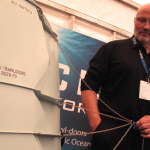Commercial Pacific bluefin tuna vessels in the United States can harvest almost 80% more in 2025–2026. The Inter-American Tropical Tuna Commission increased catch limits during a meeting in Panama in early September, reaching this decision after an International Scientific Committee for Tuna and Tuna-Like Species in the North Pacific Ocean stock assessment found the Pacific bluefin tuna stock to be rebuilt a decade ahead of schedule.
In 2022, US commercial fishing operations harvested 368 tonnes of Pacific bluefin tuna, worth more than $2.2 million. The two-year catch limit for 2025–26 is increasing almost 80%, to 1822 tonnes from 1017 tonnes in 2023–24.
‘We rebuilt the stock as a result of stringent management measures put in place on both sides of the Pacific, and the effort was not just thanks to scientists and fishery managers. We have to acknowledge the efforts the fishing industry has taken to ensure harvests remain sustainable,’ said Ryan Wulff, Assistant Regional Administrator for the NOAA Fisheries West Coast Region and Alternate US Commissioner to the Inter-American Tropical Tuna Commission.
‘The rebuilding of the Pacific bluefin stock is not only a success from a biological perspective but is also a success for the fishing communities and consumers, leading to greater economic opportunity and more US seafood available for US plates,’ he said.
The next challenge for the industry will be to rebuild markets – specifically within the United States – and educate consumers that the Pacific bluefin tuna population is rebuilt ahead of expectations.
Both the Inter-American Tropical Tuna Commission and the Western & Central Pacific Fisheries Commission adopt bluefin tuna management and conservation measures by consensus, based on science produced by the seven-country International Scientific Committee for Tuna and Tuna-Like Species in the North Pacific Ocean.
This international coordination encompasses the migration pattern of Pacific bluefin across a 6000-mile swath across the North Pacific. It spans their spawning grounds in the Sea of Japan to abundant feeding grounds off Southern California and Baja Mexico. Another subset of Pacific bluefin also travel south from the spawning ground to waters between Australia and New Zealand.
Japan and Mexico catch the most bluefin across its range. Mexico has a highly developed fishery that uses net pens to raise one- to two-year old fish in captivity until they are ready for harvest. The Commission will set new catch limits for the Western Pacific at their next meeting in November 2024.
Large highly migratory species such as swordfish, Pacific bluefin, and other tunas have rebounded in the past decade through effective fishery management and international cooperation. Consumer sentiment and domestic markets are still adjusting to these successes.
‘Fishermen are working to rebuild relationships with processors, restaurants, and other customers,’ said Michael Rubino, NOAA Fisheries Senior Advisor for Seafood Strategy.
‘They will, in their turn, have to rebuild and potentially educate their consumer base, often consisting of environmentally minded consumers who may be unaware of bluefin’s improved status. Increased catch limits represent market opportunity, but we also have to maintain and in some cases rebuild working waterfront infrastructure to land and process increased catches.’
























